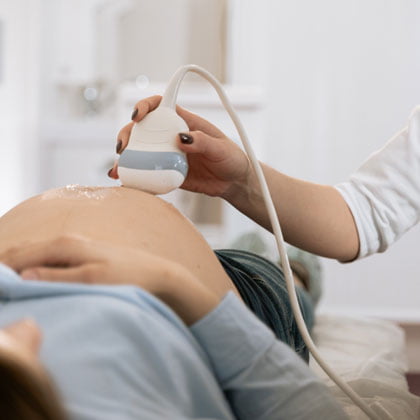
Female fertility, how to improve it?
Female fertility, what is it and how is it studied?
Fertility is the ability to become pregnant within two years of unprotected intercourse.
Fecundability is the ability to achieve a pregnancy in a single menstrual cycle, and fecundity is the probability of achieving a live birth in a single cycle.
The fecundability of a standard couple has been estimated to be between 20% and 25%, although it is clear that the probability of conception decreases over the first year to less than 10% after 7 cycles, and only 3% during the 12th cycle.6
Fertility testing
When it comes to fertility testing, the most important tests to check female fertility are3:
Ovulation analysis
It tests for the presence of the luteinising hormones ,progesterone and prolactin, which are responsible for ovulation.
Hysterosalpingography
This is a technical X-ray test that shows the structural state of the uterus and fallopian tubes.
Ovarian reserve
Ovarian reserve is a test that determines the quality and quantity of ovules available for ovulation. Women over the age of 35 should consider this test as well as other complementary tests such as blood and imaging tests.
Pelvic ultrasound
Detects conditions in the uterus and fallopian tubes.
Hormone tests
Such as thyroid and pituitary hormones that regulate the reproductive process.
What are the fertile days for a woman?
The menstrual cycle generally lasts from 21 to 35 days, from the first day of menstruation to the first day of the next menstrual period.
Generally, there are 6 days in the menstrual cycle of a woman when sexual intercourse can lead to pregnancy: 5 days before ovulation and the day of ovulation, called the 'fertile window'.2,6
Phases of the menstrual cycle or ovarian cycle
The menstrual or ovarian cycle is divided into three phases:
- The follicular phase ranges from 10 to 14 days long, and is the phase that takes place before the ovum is released.
- The ovulation phase is the phase that happens with the release of the ovum. It lasts from 16 to 32 hours.
- The luteal phase happens after the release of the ovum, lasts about 14 days and finishes with the beginning of menstruation.
During each ovarian cycle about 20 ovarian follicles are released, usually only one follicle will complete this process and be ovulated. Thereafter, the average chance of pregnancy is about 20 per cent per menstrual cycle. Only 30-50% of pregnancies result in a live birth, and most are lost even before the next menstrual period.2
Up to what age a woman is fertile?

In general terms, fertility in women begins to fall after the age of 30, and this decline increases from the age of 40 onwards.
Chronological age is the most important factor that determines reproductive success in both spontaneous and assisted cycles, as it is a predictor of ovarian reserve.
How to increase fertility after 35 years of age
As we can see, all women experience a significant decrease in fertility at the end of their thirties.
Although the use of assisted reproduction techniques or treatments (ART) has increased in the last few years, the incidence of infertility in this age group is still high.
Hence, many research studies have been concerned to find possible ways to improve fertility rates after the age of 35-40 years.
Importance of nutrition in fertility
Nutritional factors have been the subject of much of this research. There is strong evidence that healthy pre-conception dietary patterns in both men and women of reproductive age have a positive effect on fertility.8
In the Nurses' Health Study (NHS) II, it was found that women who had the highest intake of a "fertility diet" consisting of plant-based vegetable protein, whole dairy foods, iron and monounsaturated fats during the preconception period had a 66% lower risk of infertility related to ovulation disorders and a 27% lower risk of infertility from other causes.
Other factors such as age, body mass index (BMI), alcohol consumption, coffee consumption, smoking and oral contraceptive use were also taken into account in this study.8
Indeed, a direct relationship between BMI and fertility was also found from the above factors, with a higher risk of infertility among those at the lower or higher extremes of BMI, i.e. those who were either underweight, overweight or obese. 8
What are the risks of pregnancy after the age of 40?
This age, women over 36 or 40, is linked to a significantly increased risk of infertility or fertility problems, miscarriage and births of babies with trisomy 21 (Down's syndrome).
Infertility in women
The World Health Organisation (WHO) defines infertility as the inability to become pregnant after two years of regular unprotected intercourse.
Very few couples suffer from absolute infertility, which may result from irreversible, congenital or inherited loss of functional ovum or sperm, or the absence of reproductive structures in any of the partners.6
As fertility treatments have improved and assisted reproductive techniques, such as in vitro fertilisation, are now available, the term "subfertility" is being replaced by "infertility" or "sterility".
Main causes of infertility in women
The causes of infertility in women4 are divided into:
- Ovulation disorders: ovulation is either low or absent, due to polycystic ovary syndrome, hormonal disorders, ovarian deficiency or prolactin excess.
- Tubal infertility: refers to damage to the fallopian tubes, a blockage that prevents sperm from reaching the ovum or the fertilised ovum from reaching the uterus.
- Endometriosis: happens when the tissue that covers the inside of the uterus grows outside the uterus.
- Uterine causes: are those that affect the implantation of the ovum or increase the risk of miscarriage, such as polyps.
- Infertility without a clear cause.
Infertile days
As mentioned above, a menstrual cycle lasts 21 to 35 days, and the fertile window is 6 days. So the rest of the cycle, approximately 22 days, would be considered the days of non-fecundability, or lower probability of pregnancy than the fertile days.
What are the factors that negatively affect fertility in women?
The main factors that negatively affect fertility in women include the following:
- Age, due to a decrease in the quantity and quality of the oocytes.
- Weight, both underweight and overweight or obesity affect ovulation.
- Sexual history, as sexually transmitted diseases (STDs) such as gonorrhoea or chlamydia can cause damage to the fallopian tubes.
- Alcohol, which reduces fertility.
- Smoking, which can damage the fallopian tubes and uterus.
What factors help fertility in women?

Among the factors that contribute to a natural fertility in a woman are the following:
- Endocrine factors, defined by proper functionality of the menstrual cycle and ovulation.
- Fallopian tubes and uterus, defined by both proper structure and function.
- Endometrium, the quality of the mucous membrane covering the uterus.
- Lifestyle, including diet, weight and the quantity and quality of sexual intercourse.
Foods that help female fertility
As we have seen above, there is strong evidence on the relationship between fertility and nutrition. A balanced and healthy diet is the key to the well-being of our bodies and fertility.
Foods we should include to help fertility are: green and yellow leafy vegetables, fruits, milk, seeds and legumes, lean meat, liver, fish high in unsaturated fats, oils high in Omegas (such as olive oil) or whole grains.
Vitamins and minerals related to female fertility
Proper nutrition before and during pregnancy is important to ensure optimal health and well-being for both mother and baby.6
Although many of the necessary nutrients are present in foods, physiological needs during preconception, pregnancy and lactation may require extra dietary supplements.
Micronutrient deficiencies have been associated with significantly high reproductive risks, from infertility to structural defects in the fetus.6
Supplements for female fertility
Here are some ingredients within food supplements that are helpful for female fertility.
Folic acid and female fertility
Folic acid, a water-soluble B-complex vitamin, is necessary for DNA formation and cell division. It is a nutrient now recognised as important before and during pregnancy because of its proven preventive properties against neural tube defects.
Improving folic acid intake before pregnancy may reduce birth defects and maternal megaloblastic anaemia.6
EFSA recommends 250 micrograms/day of folic acid in adults over 18 years of age and in pregnant women.
During the preconception period, an intake of 400 micrograms/day is recommended.7
Omega 3 for female fertility
In women over 35 years of age, important changes in fatty acid metabolism begin to take place which can affect the quantity and number of ova. It is therefore important to ensure a good intake of Omegas 3, 6 and 9, especially Omegas 6 - GLA.
The EFSA recommends the following intake of Omegas in pregnant or expectant mothers, in the following amounts:
- Intake 250 mg/day DHA and EPA + additionally 100-200 mg/day of DHA alone (Omega 3).
Regarding the amount of omegas taken in the diet, the following levels of Omega 3 and Omega 6 are recommended:
- Intake 0.5% of Alpha-linolenic acid (Omega 3) of total energy intake.
- Intake of 4% linoleic acid (Omega 6) of total energy intake.
Omega 3 and Polycystic Ovary Syndrome
In Polycystic Ovary Syndrome (PCOS), the use of Omega-3 has been shown to be beneficial. This syndrome is defined by menstrual irregularity, insulin resistance, diabetes and obesity.
In a meta-analysis of several studies involving 591 women with PCOS, taking Omega-3 for 12 weeks reduced both insulin resistance and blood lipid levels (triglycerides and cholesterol).
Peruvian Maca and fertility
Lepidium meyenii, also known as maca, is a Peruvian plant belonging to the Brassicaceae (Cruciferae) family.
The reproductive benefits of maca have been linked to its popular use since ancient times. Many of these benefits have been scientifically proven.
With regard to the nutritional value of maca, its most important bioactive is glucosinolates, which have been shown to have a positive effect on the reproductive area.
Maca tubers also contain approximately 13-16% protein, a high amount of essential amino acids, polyunsaturated fatty acids, as well as high amounts of iron and calcium.
A 2016 study involving 175 participants showed the benefits of maca on energy metabolism, mood and sexual desire.
The usual dose of maca is 1 gram/day and is for use by adults over the age of 18. It is not recommended for pregnant or breastfeeding women.
Vitamin B12
Vitamin B12, or cobalamin, is found only in animal foods. This vitamin is involved in the proper functioning of liver metabolism (homocysteine), as well as in the formation of haemoglobin and the metabolism of fats and proteins.
Especially homocysteine disorders can affect fertility by affecting the quantity and quality of ovarian follicles, as well as the quality of the embryo formed after fertilisation.
The EFSA recommended daily intake of vitamin B12 in pregnant women is 4.5 micrograms.
Before pregnancy, the recommendation is 2.4 micrograms/day.7
Vitamin D
Vitamin D promotes the production of reproductive hormones - progesterone, oestradiol and oestrone - which are involved in both ovulation and implantation of the fertilised ovum in the endometrium.
This vitamin is also involved in the growth of uterine tissue, the production of the hormone chorionic gonadotropin (a marker and regulator of pregnancy) and the formation of the placenta.
Vitamin D intake in pregnant women is recommended by EFSA at a dose of 15 micrograms/day (600 IU/d).
During the pre-pregnancy period the recommendation is 5 micrograms per day.7
Iron and calcium
Iron is of great importance to women at different stages. With regard to fertility, analysis of the Nurses' Health Study II6 , a study of more than 116,000 women aged 24-42, showed that intake of iron supplements and non-heme iron from food can reduce the risk of ovulatory infertility.
"Iron deficiency and anaemia affect women more because they lose iron during menstruation and need more iron when they are pregnant or breastfeeding," says the Spanish Society of Haematology and Haemotherapy (SEHH).
Calcium plays a key role in fertility, specifically during the preconception stage, as it is involved in the ovulatory processes (luteal phase) and in the regulation of the hormones that regulate the reproductive process.
Calcium is essential for bone development and maintenance, and this process is also linked to vitamin D, so any woman, whether preconceptual, pregnant or breastfeeding, should be recommended to take calcium intake.
The EFSA recommended intake of iron and calcium in pregnant women is 7-16 mg/day and 860-1000 mg/day, respectively. For preconception women the recommended intake is 750 mg calcium a day and 7 mg iron a day.





